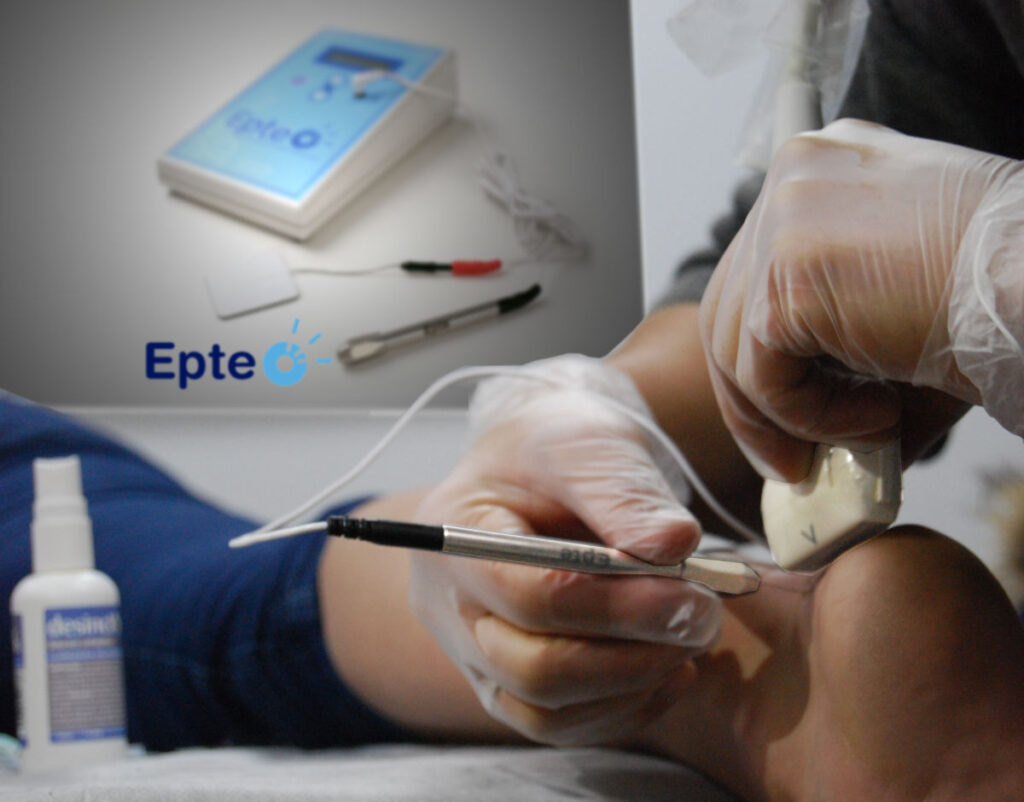The percutaneous electrolysis EPTE® technique involves the application of a galvanic current through an acupuncture needle to accurately reach the damaged part of a tissue. It is currently used by more than 2,500 Physiotherapists, Doctors and Medical Practitioners in 26 different countries and this number continues to grow on a monthly basis. Both the basic and advanced course have been developed by leading experts in the Research and Training Physiotherapist department of EPTE®. The first course in the United Kingdom has been held in London, on the 24th & 25th of June.
Program
http://www.electrolisisterapeutica.com/en/program-percutaneous-electrolysis-course/
The application of the EPTE® percutaneous electrolysis technique is an evidence based approach that has been developed following the completion of much scientific research and following the production of many studies and papers. The course begins with a re-introductory module on the tendon injury pathophysioulogy including the evaluation & diagnosis based on the different kind of imaging devices available. It also includes a review of the different treatments for tendinopathies according to the best and most recent evidence available, as well as the different programs of therapeutical exercises and load management used, as a part of a global treatment with EPTE®. The main part of the course is very practical and focuses on the 5 approaches to treating the following tendinopathes based on the most up to date scientific evidence: Patellar tendon, Achilles, Plantar Fascia, Supraspinatus and Epicondyle tendon.
- Register for the next EPTE® percutaneous electrolysis course in London.
The history of Percutaneous Electrolysis.
Electrolysis is not a new concept. It was discovered by the British chemist William Nicholson in 1800. The electrolysis laws were described by the famous physicist Michael Faraday (Newington Butt, 1791 – Hampton Court, 1867). Electrolysis is a physical process caused by an electrical current.
The therapeutical application of electrolysis allows for an inflammatory change to be made in the tissue, without applying a physical load through the tissue. Using an acupunture needle, the percutaneous tissues (tendons) can be reached more accurately, allowing for a more focused treatment. In the case of tendinopathies, the electrolysis effect induces a controlled inflammation in the damaged tissue which therefore re-starts the healing process of the tendon. (A damaged tendon has less type I collagen than a healthy tendon).Percutaneous Electrolysis Therapy (or EPTE®) uses micro-currents (μA) applied via an acupuncture needle.
Aims & Objectives of the EPTE® Course of Percutaneous Electrolysis:
- To provide an in-depth and up-to-date knowledge of tendinopathies and their pathophysiology.
- To introduce the EPTE electrolysis device and teach the various applications and approaches to use the correct level of the galvanic micro-current
- Knowing the applications of the galvanic micro-currents for the correct electrolysis approach.
- To provide a review of the latest scientific evidence regarding best clinical practice in tendinopathy diagnosis and treatment.
- To share a wealth of clinical experience in electrolysis treatment
- To provide the necessary supervised practical knowledge and hands-on experience in the application of percutaneous electrolysis to ensure that practitioners leave the course feeling confident in using the different treatments.
EPTE® course data:
Currently there are over 2,500 physiotherapists, Doctors and Medical Practitioners using Percutaneous Electrolysis Therapy as a treatment technique in 26 different countries. The average EPTE® treatment lasts 5 weekly sessions with one session a week.
- 150 courses have been carried out in the last 3 years
- Over 3,000 students have been trained in the use of Percutaneous Electrolysis Therapy.
- There are currently 1,200 EPTE® official centres
- EPTE currently have the following courses available: Percutaneous Electrolysis Therapy Basic course, Percutaneous Electrolysis Therapy Advanced Course and EPTE Inertial Training.
We also recommend this other article:
http://www.electrolisisterapeutica.com/en/10-reasons-to-choose-percutaneous-electrolysis-epte/

